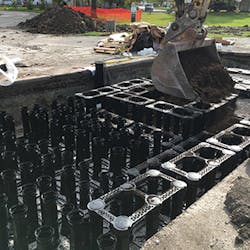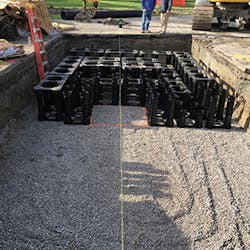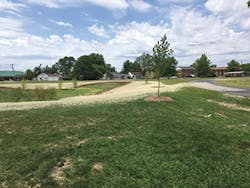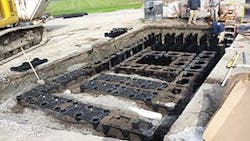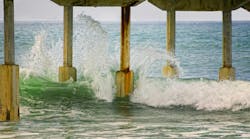The office of the Ohio Lake Erie Commission (OLEC) sits with its windows facing the water. And what better location than this Sandusky-based office to observe firsthand the often temperamental and recently the most media-headlining water body of the Great Lakes?
According to senior environmental specialist Sandra Kosek-Sills, the official mission of OLEC, which was founded in 1992, is to preserve the lake’s natural resources. That’s a tall order, which includes protecting the quality of its waters and ecosystem and promoting the economic development of the region. “We work to coordinate policymakers, state government programs, and regional collaborations toward best practices of water quality by lowering toxic substances and by managing costal resources,” she explains. “We also advise the governor and senior state executive management on projects being developed or implemented toward those goals.”
“On a broader scale we represent Ohio and the lake in outside arenas—from regional to international forums—where those discussions focus on water quality efforts. Furthermore, we assist in implementing the Coastal Zone Management Program and the Great Lakes Restoration Initiative [GLRI], and we manage the distribution of money from the Lake Erie Protection Fund [LEPF],” whose income she adds, is derived from direct donations and the sale of Ohio vehicle license plates featuring notable Lake Erie icons.
But one of the most pressing day-to-day concerns is nutrients, a problem that in the last decade has resulted in an increasing number of algal blooms, causing a temporary shutdown of nearby Toledo’s drinking water source in 2014, occasionally curtailing tourism and fishing during parts of the late summer, and affecting commerce, municipal water management, and public engagement with the waters of Lake Erie.
“While nutrient loss on farmland draining our tributaries to the lake is a huge issue for the agricultural sector, we want everyone who has stormwater runoff to take responsibility,” she says. “Everyone can take responsibility for their place, and their piece, in this very complex puzzle.”
She adds, “There is a role that reducing nutrients in urban stormwater will play, and perhaps of even more significance to some communities than that impact on Lake Erie is the impact on their own local water resources.”
She notes that the legacy of the now-prevalent combined sewer systems remains a concern, although a lot of effort is underway to fix the problem. “Everyone used to think this was a good idea; it was well intentioned. But today, while we’re seeing fewer rain events during a year, there is a significantly increased volume, and often in a shorter space of time in the spring. What happens is that these combined systems are overloaded; the water travels to outfalls and bypasses some treatment.” Kosek-Sills says that to confront the dilemma, “millions have been spent by ratepayers for separations to address this, and we are beginning to see good results.”
For regions like the western Lake Erie basin, with a high water volume and a high potential for nutrient-laden runoff, the results of combined sewer overflows (CSOs) are often catastrophic.
“In this region we are asking everyone to do their part, and there are some very interesting projects in place. These are simple, green technologies to capture stormwater, slow down the velocity to the system, and filter the water in the process.”
One agency is coordinating widespread efforts toward urban nutrient reduction, says Kari Gerwin, director of water quality planning for the Toledo Metropolitan Area Council of Governments (TMACOG).
“We work with a coalition of 26 local government members who work cooperatively to address stormwater issues and meet the requirements of the Ohio EPA stormwater permit. Our members are managers of storm sewer operations in northwest Ohio, right along the Maumee River and other Lake Erie tributaries. Working alone, individual municipalities may not have the resident expertise they need for outreach, education, program administration, and so forth, but a cooperative approach enhances the capacity of each member organization,” says Gerwin.
She explains that, like most urban areas in the Midwest, member jurisdictions of the stormwater coalition experience a repeated problem during a big rain event. “We get a huge flush of stormwater that isn’t getting any treatment and just flows through the storm sewer system into our local waterways, so by slowing down and capturing water, putting it through an infiltration practice, we are solving multiple problems in one project.”
To address the problem, TMACOG wanted to take vacant parcels where structures had been demolished and use those to demonstrate the stormwater management and pollutant reduction benefits of green infrastructure. With the help of a grant from the Great Lakes Restoration Initiative and Ohio EPA, which administered the grant, the group launched an effort to install two biocells in 2015.
“We had a specific site in mind in the city of Toledo,” she notes. “Abandoned houses had been demolished on five adjacent parcels over the course of several years, but the remaining basements, driveways, and other infrastructure had to be removed and landfilled before we could start our work. The City of Toledo engineers designed the slope and specified the materials to be used on these biocells.”
Matt Pesci of Mannik & Smith Group Inc., who managed implementation of the project, describes the work: “The initial excavation at each biocell was 5 to 6 feet below the existing grade, and then it was backfilled with filtering materials. This put the finished biocell basins 3 to 4 feet below the surrounding grade, with a 4:1 slope down into the basins.”
Gerwin and Pesci both agree, however, that even before work began, it was important to go out into the neighborhood areas to gather input and to explain the reason for the project.
“Our goals were to both achieve a good infiltration based upon the engineering component and to achieve an aesthetic that fit the neighborhood and would make residents happy,” says Pesci.
Gerwin adds that the outreach portion is extremely critical to get buy-in from the community. “We learned that we have to really explain why we are doing this work and how the benefits will be an immediate bonus to residents beyond reducing stormwater runoff, like providing landscaping on overgrown vacant lots and reducing flooding in basements and streets. This particular project taught us that we have to also engage individual neighbors to gather their input on plant selection and the overall site aesthetics. The message we’re trying to communicate is that at the end of the day it adds overall value to their community.”
Gaining this kind of on-the-ground support for green infrastructure projects can also encourage others to take ownership in their community. While the City of Toledo will conduct regular maintenance of the biocells, community members have become involved in volunteerism by organizing cleanup days, weeding, and collecting seeds in the fall.
Project landscaping manager Alex Duncan, then with A&J Landscape Center, agrees that the project was a benchmark for education and engaging the local community. “When we held educational events to explain what we were doing, and our company presented the types of native plants we intended to use, we also explained why. For example, at the bottom of the slope we chose milkweed, which can withstand having ‘wet feet,’ and then farther up where it is drier, we used bunch grass, which has good winter interest, and at the top of the slope where there might be drought, a hardy little blue stem flower. Sometimes the most workhorse plants are not what people expect, so we have to explain these are ‘working plants,’ not just decorative.”
Duncan says that because the completed 12,000-square-foot biocell drains a lot of area, plants “must perform multiple duty. They must be hardy with good roots to hold water, be sustainable through extreme heat and drought, and withstand excessive wet conditions.”
Gerwin adds that the engineering design helps quantify the project’s success. The two biocells on the 3/4-acre site manage stormwater from a 5-acre urban residential area. For every 1 inch of rain that falls in this area, the biocells capture and filter about 32,000 gallons of polluted stormwater. Any excess that doesn’t infiltrate into the ground is then slowly released to the combined sewer system through an underdrain.
“Our estimate is that these biocells are reducing nitrogen by 33 pounds a year, phosphorous by 6.5 pounds, and total suspended solids by 900 pounds a year,” says Gerwin.
Duncan agrees that this demonstration project illustrates the concept that “every little bit helps.”
“No matter how small, if you have water on your property, use that water; let’s capture it as a resource and grow something. Each effort has an impact on stormwater management. There’s no silver bullet that will solve all our stormwater issues, but there are abundant opportunities with green roofs, rain barrels, wetlands, and riparian restorations. It’s not one size fits all, and in this area it’s essential to get the community involved to learn, to understand, and to participate. Collectively, this can make a huge impact on the health of Lake Erie.”
Finally, Gerwin says that the stormwater coalition is helping to facilitate opportunities for developers to understand the importance of stormwater management and the need to manage pollutants.
“Through our coalition we are trying to create more consistency on how site plans are reviewed; the city of Toledo has one set of regulations, then out in the suburbs they can each be different. The lack of consistency can create headaches for everyone. By working with all our local governments in the region, we can strive toward more uniformity and spend less time reviewing plans and encourage post-construction filtration efforts,” she says.
She adds that although urban runoff contains the usual hydrocarbons and heavy metals, which various BMPs can help to keep out of waterways, there is also “a huge problem with sediment.”
“We need to educate communities and developers that this fine sediment is washing into our rivers and streams off lawns, off roadways, and it severely impacts the benthic habitats so crucial to wildlife and to these waterways. To help monitor this situation, we are now in our 29th year of Student Watershed Watch. This is a program where every year local students and teachers get out into the waterways and measure water chemistry, physical properties, and the macroinvertebrate communities. They look at specific stream segments and compile data that is important to understand the human impact on waterways.”
The program, she says, is “just another illustration of everyone doing a little bit, getting involved to help.”
Planning Across Borders
Although newsworthy events fade over time, the burning of the polluted Cuyahoga River seems indelibly stamped onto the collective memory. The 1969 fire in downtown Cleveland prompted action and helped bring about the Clean Water Act of 1972.
Frank Greenland, director of watershed projects for the Northeast Ohio Regional Sewer District (NEORSD), says that on the heels of the Clean Water Act, local environmental pressures led Cuyahoga County Court officials to take action locally. “They ordered the founding of our regional sewer district,” he says.
“Our jurisdiction now covers about 350 square miles and includes about a million people, and we’ve grown to 62 member communities. The NEORSD was deemed essential to solve myriad problems and to address consistency in water treatment that today involves stormwater and wastewater treatment through our now-three treatment plants and service to customers across nearly 7,000 miles of pipe; this includes the service laterals to home and industry.”
He outlines the four primary responsibilities as mandated by the court order.
“First, we have the task of operating and maintaining, as well as upgrading, three wastewater treatment plants that provide service east, west, and south in our jurisdiction.
“Next, we created and installed interceptor sewers. You might describe this as a highway of sewage from multiple communities in local areas, and this converges for treatment at one of the three plants. While we own the highway network, each community owns and operates its own sanitary and stormwater, or their own combined network.
“By building the interceptors, we have provided capacity to help alleviate basement flooding and doing so also alleviates overflows by increasing capacity, which keeps down the CSO discharge.”
He says the third responsibility is to reduce the combined sewer overflow discharge through the 122 permitted outlets located in the City of Cleveland and several inner-ring suburbs.
“Through our Project Clean Lake initiative, we have a consent decree with the state and federal governments to dramatically reduce combined sewer discharge, and we have done just that—from 9 billion gallons in the 1970s to 4.5 billion today, and the Clean Lake project continues to cut those numbers.”
The fourth responsibility of the district “is to act as a regional stormwater management authority and to work with 56 communities we serve to solve intercommunity problems. Water doesn’t stop at city or township boundaries, so we needed the authority to evaluate, help orchestrate, and implement plans that cut across those boundaries and serve the needs of all without exclusion.”
He cites the stormwater responsibility as a big issue, affecting flooding, erosion, and water quality.
“The big problem is that runoff from impervious surfaces can quickly overwork the system, and as streams take on more water than they are used to, they erode. The result of this excessive water changes the stream dynamics, which impacts the habitat. We’re trying to attack this on all fronts by educating the public and offering credits for BMPs and infiltration projects that slow down or treat all this runoff,” says Greenland.
He says the most critical piece for any authority or organization with similar challenges is having a master planning study to really investigate the problems, causes, and strategies.
“We’re spending $5–10 million in each of four study areas to look at the issues of stormwater on area streams. We’re looking at sediment and nutrient reduction, basement flooding, water quality—it all takes investment and can involve big-ticket items. By working with our members and analyzing our situation as a whole, we can help member communities ensure their investments and environmental efforts are wise ones.
“Water spans these community borders, and if we built facilities without accommodation for the downstream effects, you end up paying twice the price,” he cautions. But he adds, “The good news is that the efforts are working.
“Our latest success story is we now have a pair of nesting bald eagles on the Cuyahoga River, and that is clearly a testament by Mother Nature to spectacular improvements—what better endorsement could there be.”
Small Town, Big Gains
At the confluence of three rivers (Maumee, Tiffin, and Auglaize) sits Defiance, OH, a small town of 17,000 that Jennifer English, the city’s MS4 coordinator, says is “a very interesting point in the Western Lake Erie Basin.”
“The Maumee River has the largest watershed in the entire Great Lakes, and hydrologically this includes more than 6,600 square miles. Right now we are seeing nutrients as our biggest concern.”
In fact, during the summer of 2016, an algae bloom appeared on the main stem of the Maumee River. This clearly conveys the message “close to home when it is at your front door,” English says.
“Our system, like so many older cities, is a combined one, and we are grappling with overflows; nobody wants sewage flowing directly to their water supply. But unique to us is that our drinking water does not come from Lake Erie, but from the Maumee River, so we are especially concerned about protecting public health and the health of the river and the lake.
“While there is an EPA mandate to reduce CSOs, building a new gray infrastructure system will cost us millions and can be more disruptive to the communities than green infrastructure,” she explains.
To help manage the runoff and the CSOs, the Ohio EPA Surface Water Improvement Fund (SWIF) has provided funding to the city for the Diehl Park Project, which employs sustainable, green solutions that directly target runoff issues.
“Water is a valuable commodity, but we’ve been conditioned over the years to the perception that rainwater is simply a waste product to get rid of—the faster the better. Nothing could be further from the truth.” She says that putting green space to work is an ideal solution and cites Diehl Park as a showcase for the objectives “slow it down, spread it out, soak it in.” “We want to encourage the stormwater to slowly filter through the soil and recharge the groundwater.”
The 40-acre park and community showcase for family recreation not only got a major facelift but also is reducing the burden to the stormwater system. The first step was removing the park’s connection to the combined sewer system.
English says a grove of mature hardwood trees in the park was preserved to continue performing multiple duties: providing shade, CO2 absorption, and water absorption and retention, as well as adding important aesthetic value. “Each full-grown tree can transpire 40,000 of gallons of water a year,” English says.
A selection of native trees and shrubs were chosen for their hardiness and water absorption capacity and planted throughout the project, some within Silva Cells. Silva Cells are modular plastic frames with a design that can support traffic loads and allow for permeable pavement above. They can be used in parking lots, sidewalks, and streets. But the real bonus, she says, is that “the underground ‘cage’ system can use soil volumes to enhance the growth of large trees; it’s like a playground for roots.”
As the roots grow, English says, they can easily spread horizontally and vertically. The Silva Cells, which are manufactured by DeepRoot Green Infrastructure, also provide nutrient removal while absorbing the rain and runoff.
“Water from these frames has been naturally and slowly filtered. Excess stormwater then flows into the park’s bioretention basin, where it can further soak into the soil and to the specially chosen plants.”
Finally, any water remaining will flow into the existing storm sewer and to the Tiffin River; however, “at that point it has been through a number of beneficial filtrations,” says English.
“We’re all so proud of this project; it is beautiful and functional. This is a perfect example of how we can take what appears an overwhelming dilemma but with creativity and ingenuity turn the problem into a solution, one drop at a time.”
Reclaiming Successes: Dry Basements, Reduced Nutrients
When a series of isolated summer storms sweeps across the Lake Erie basin, Toledo residents are reminded of their vulnerability to nature. Arguably, no one is more familiar with the impact and complexities of those excessive stormwater events than Patekka Bannister, Toledo’s commissioner of plant operations. She says her former post in Environmental Services, where she had oversight of industrial pretreatment of stormwater, was a valuable experience that “really gives me a unique perspective on stormwater.”
She says, “We have so many nutrient issues in this western Lake Erie basin that preparing for, managing, and mitigating stormwater overflows is an ongoing way of life.”
As in most communities with close ties to important waterways, “people really see the effect on their lives of water-quality issues, and in 2002 they voted a rate increase to address the overflows.”
She describes several initiatives that have been implemented to mitigate nutrient loading. These include a phosphorous limitation of 1 milligram per liter from the Toledo Water Reclamation Facility, which discharges to the Maumee River and feeds Lake Erie. “We are using iron as an additive to enhance the phosphorous removal.”
The city also implemented a stormwater utility and management program. “This program includes regulating runoff through use of BMPs such as detention basins, filter media barriers, interceptor swales, and drainage controls on construction sites. All of these practices help us trap phosphorous before it reaches our local waters,” she says. (See “Pennies From Heaven” in this issue for more detail on the utility.)
Bannister adds that the city invested in an educational program, Clean Water Clear Choices, “to engage citizens on how they can play their part. Residents learn strategies to manage pet waste and lawn fertilizer and to encourage pollinators, all of which tie in with creating a green infrastructure to manage runoff and overflows and ultimately improve our environment and everyone’s quality of life.
“The great thing about green infrastructure in the world of stormwater is it’s something citizens can do. Scout troops, churches, schools, local communities can all get involved to develop rain gardens. Plus with education outreach, our local industries are increasingly onboard with amending low-lying areas, installing bioswales, and landscaping to improve drainage and filtration on their properties.”
She says the more water that can be reclaimed, the more the city can reduce nutrients.
“There are so many benefits to managing nutrients, so engaging everyone in the effort to achieve our goals is absolutely essential. You can’t assign the problem and responsibility to just one sector. Agriculture, industry, the homeowners—everyone needs to get onboard, and we’ve seen this approach work.”
Bannister says the strategic and holistic approach to managing nonpoint-source nutrients in her jurisdiction’s tributaries is another responsibility. Using both Ohio EPA and US EPA watershed planning parameters, “each tributary is evaluated against the nine parameters that help municipalities identify specific problems and causes of those as they affect each waterway. For example, we look at sources, effects on wildlife, stormwater, and public health and then can create master plans, amendments, and analytic tools focused on those specifics.”
She adds, “Understanding the connection of nutrients and stormwater overflows as it affects our lifestyle and public health is essential. We’re getting the message out and public and private buy-in to implement solutions by adopting more permeable surfaces and plant materials that retain and slow down water. It’s not a quick fix, but when beaches and boat launches are open, fish limits are increased, and your basement is dry, you can’t help but be a believer.”
Every summer, thousands flock to Cedar Point, OH, the country’s second-oldest operating amusement park, complete with historic hotels, boardwalk, beaches, and entertainments. Opening nearly a century and a half ago—originally as a freshwater bathing site—Cedar Point attracted savvy entrepreneurs, who quickly recognized a golden opportunity on this peninsula of the southwest shore of Lake Erie near Sandusky.
Located equidistant between Toledo and Cleveland, here was a naturally pristine venue that would attract enthusiasts from everywhere. And it did. With its exciting new attractions and white sand beaches, the park heralded the advent of commercial tourism. By the turn of the century, it was transformed with an electric power plant that brought power to the amusements, hotels, ballrooms, and attractions. Patrons were happy, and that small town on the western edge of Lake Erie, Sandusky, was launched onto the national map as a desirable destination.
At about the same time, a research laboratory affiliated with The Ohio State University on the park’s neighboring Gibraltar Island began expanding. The now-renowned F.T. Stone Laboratory, with its century of Lake Erie observation, testing, and monitoring, is the oldest freshwater field station in the US. And probably the only one with its own castle—Cooke Castle—built by a Civil War financier when the island was still private property.
Today, there is also much more activity. Ships in the Toledo harbor export the largest quantity of soybeans globally. The city of Cleveland enjoys a well-publicized renaissance and renewal. And the region is also the site of numerous vital endeavors by local municipalities, community organizations, not-for-profits, individuals, and state and federal agencies, all committed to ensuring that Lake Erie, that jewel in the crown of not just the regional prosperity, but also a source of valuable natural resources, is carefully managed, protected, and cherished.

